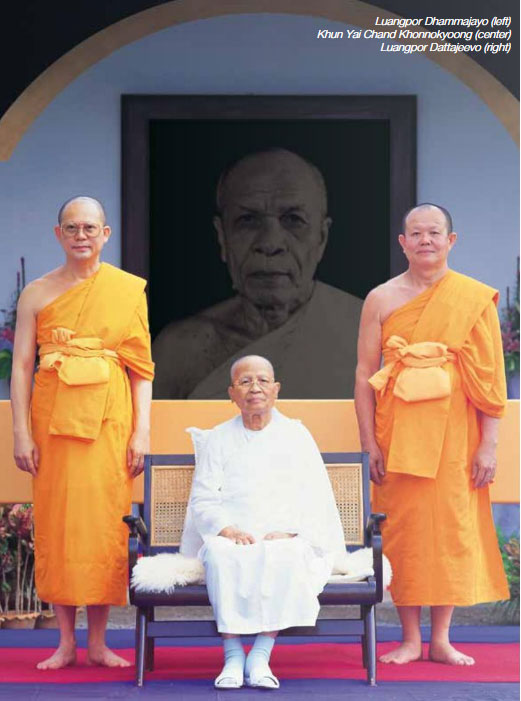
As if in response to Luangpu's prophecy, a new generation of students interested in meditation started to come to Wat Paknam to learn meditation from Luangpu's top disciple, Chand Khonnokyoong, at her humble kuti. By then Chand's reputation as a highly accom plished meditator was known throughout the community. Her students called her "KhunYai", a Thai word for "grandmother", as a way of respect for her advancing age. Chand's meditation teaching was so popular that soon the group outgrew the space at her kuti. She subsequently built a larger facility within the compound of Wat Paknam and moved her meditation class there. Before long, the new facility was also outgrown.
Among Chand's students were two promising young men, Chaiyaboon Suddhipol and Padej Pongsawat, both of whom were students from Kasetsart University. After Chaiyaboon graduated from the university in 1969, he became ordained as a Buddhist monk at Wat Paknam and was given the monastic name, "Dhammajayo Bhikkhu". After Chaiyaboon's of dination, Chand felt the time was right for her and the team to build a Buddhist temple where true monks could be developed and the Dhammakaya Knowledge could be propagated to benefit the public at large. This was indeed a grand vision. To fulfill this vision, a great deal of financial resources would be needed. Unfortunately, all that Chand had was her own savings of a mere 3,200 Baht (US$160 in 1970). But Chand was a perpetual optimist who was driven by merit and merit power. She strongly believed that the virtue of good deeds performed by her and her team members would attract sufficient "celestial treasures" to make this mission possible.
Chand and her team envisioned that their future temple would be built on a sizeable piece of land not too far from Bangkok, with a river or creek flowing through it. The team set out to look for such a land. They found a track of land in Pathumthani, a paddy field ten miles from the Bangkok International Airport (Don Muang). The land was owned by Lady Prayad, an aristocratic lady of advancing age. The team was not certain that Lady Prayad would be willing to sell part of the land she owned, but proceeded to arrange for a meeting with her anyhow. The day that Chand's team met with Lady Prayad also happened to coincide with Lady Prayad's birthday. It was a lucky day for Chand and the team. Not only was Lady Prayad willing to part with the land, but she was in fact willing to donate the entire 78.4 acres of her land to the future temple. This was nothing short of a miracle.
The temple was formally established on Magha Puja Day, February 20, 1970. It was originally called Buddhajak Meditation Center and was later changed to Wat Phra Dhammakaya (The Dhammakaya Temple). The Main Chapel was completed in 1982. The property was later expanded to 1,000 acres in 1985. The Maha Dhammakaya Cetiya, a monumental dome-shaped Buddhist shrine where there are 300,000 Buddha images enshrined on the exterior and 700,000 Buddha images enshrined inside, was completed in the year 2000. The Grand opening ceremony of the Cetiya took place on Saturday, April 22, 2000. Chand Khonnok-yoong was 91 years old when the Cetiya was completed. She lived to see that big day.
The Maha Dhammakaya Cetiya is indeed a gift to mankind. The compounds surrounding the Cetiya are now the gathering ground for Buddhists around the world. Over one million Buddhists gather at the Cetiya during important Buddhist events.
Chaiyaboon Suddhipol and Padej Pongsawat (who ordained subsequently) are the current Abbot and Vice Abbot of Wat Phra Dhammakaya respectively. They were the driving force behind many of Chand's successes. Wat Phra Dhammakaya, Chand's brainchild, is now one of the largest Buddhist temples in the world with over one hundred and sixty branches in thirty-three countries, and growing.
The success of Wat Phra Dhammakaya is a tribute to the living legacy of the Great Master Luangpu Wat Paknam.
Even though the light that Luangpu Wat Paknam had shone forth
to the world is now extinguished, the flame of his teachings burns on.
To this day, the heritage of the Dhammakaya Knowledge continues
to flourish in all walks of society. Millions of people throughout
the world now practice the Dhammakaya meditation
tradition taught by Luangpu Wat Paknam.
Luangpu's teachings have helped people discover that true peace
and happiness can indeed be found within one's own self.